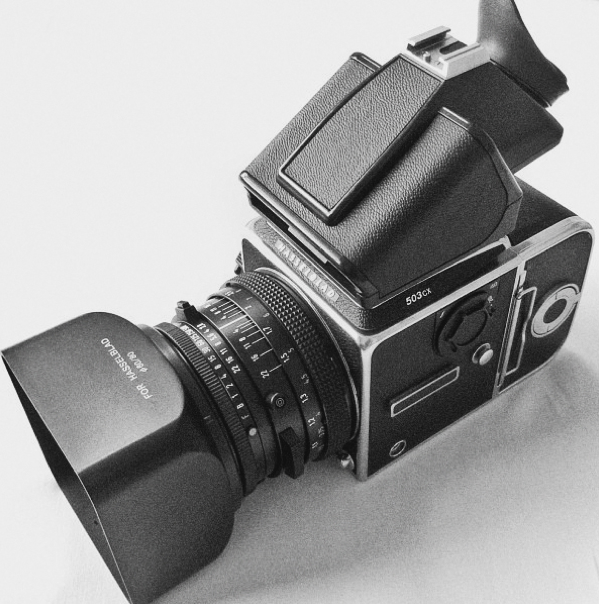As a photographer, I have always been curious to know how does it feels to actually hold and shoot the world’s first camera which travels to the moon. The brand Hasselblad or Hassie in short has been synonym with amazing picture quality and workmanship as well as high flexibility. I can still remember the day clearly when I first collected the camera from the KLIA custom ( i got it off ebay ) . Opening up the parcel with utmost care and assembling the camera part by part while in the car until it finally take shape is truly hard to forget.
The 500cm as well as the rest of the Hassie are modular system cameras which allows user to mix and match the components whichever suits their needs. In other words, the photographer have the flexibility to choose different bodies, film or digital backs or even Polaroid back, waist level or prism finder, focus screen as well as manual or motorized winders as per one’s preference / needs. I have both the 500cm as well as 503cx and they are almost identical. The only difference between these two siblings is the 500cm the more down to earth brother while the 503cx come with palpas internal coating at shutter curtain and mirror chamber which supposed to have a slightly better light absorption. The 503cx has the ability to do center-weight TTL Flash metering with appropriate SCA modules with certain capable flashes. Hence the 503cx has an ISO dial on the left side of the body as shown on the image on top. I use the 500cm more for natural light / out door shoots while the 503cx more for studio application as well as a back up. Both or can I say all the film Hassei runs on 120 / 220 film and it shoot 6x6 format which is Square ...think Instagram ! : )
I have replaced the original split focusing screens on these two Hassie with a high brightness Accumate screen which works really awesome. The clarity and brightness improved tremendously. I have also purchased a metered prim finder to go with it. I would highly recommend these two combination though the upgrade is not cheap. Prob will set you back around USD 350 for one set.
Starting with the body, the built quality and material used is indeed top notch. This Swedish made camera is cast out from an aluminum alloy body which is indeed very solid. The Carl Zeiss Planar 80mm f2.8 CF T* is one of the fastest lens in the Hassie line up. It’s small and light weight despite it’s metal construction. The focal length is almost equivalent to a 50mm lens on a full frame camera hence it's very useable. The CF*T lenses is the second generation Planar and it comes with Zeiss T* coating which helps with flare reduction. What I love most about this lens is the creamy bokeh as well as the amazing color reproduction. It’s to die for ! The sharpness is good even wide open. Being a medium format, the subject on the image just pops right out of the negatives / scans. I am starting to understand why Rolleiflex 2.8F , Rolleiflex SL66 as well as the legendary Contax 645 ( f2 version ) uses the 80 Planar lens. All the Hassies lens have a locking EV value on the aperture ring and shutter speed ring hence changing depth-of-view ( F stop ) while maintaining the same exposure during middle of a shoot is really a breeze.
In term of useability, the camera is pretty light for a medium format and it's so easy to size it down when you are traveling. Just replace the metered prism finder back with it's original waist level finder that would save you around 160gs easily. The Hassie fits perfectly into a Billingham Hadley Pro with two additional film backs being stored on the front pouches. Just awesome !
For first timer, using the Hassie is not an easy task. There are a lot of steps involved and the most crucial is to fully wound / cock the shutter before you remove the lens or film back. There is a coupling system between the camera body and the lens right at 6 o'clock of the lens mount. It needs to be aligned accordingly ( in the horizontal position ) in order to mount the lens correctly without damaging the camera.
If the lens is removed when the shutter is not cocked, the cam on the lens will spring to the vertical position. You would have to use a small screw driver to turn the cam clock wise as per the arrow indication until the slot is aligned with the red dot on the left as per below diagram. Only then you can mount the lens back to the camera body.
On the right side of the camera body, there are also two indicator who show the status of the shutter, RED = Uncocked WHITE = Cocked. Both indicator on the body as well as the film back needs to match as well in order to mount. Hence as a general rule of thumb, make it a habit to cock the shutter all the time right after you fire a shot and you should be pretty much save from damaging the camera. Don't ever remove the lens when the shutter is not cocked else you will risk damaging the camera !
Pros : It's modular and very versatile. Very well built and the Zeiss 80mm f2.8 CF optics is amazing even shot wide open. I absolutely love this glass ! I love the replacement accumatte focusing screen too. It's among the brightest in the market which makes focusing such a breeze.
Cons : The body and lens coupling can be a little tricky for new user . Make sure you spend time to read the user manual thoroughly before using it . It's also not cheap.
Buying tips : The price for the 500cm has been escalating quite a fair bit for the past two years specially with the Zeiss 80mm f2.8 CF*T lens. I foresee this particular model will appreciate it price and become more collectible as it is really well made and a true classic. As the Hassie body is really simple in construction ( which basically is just a small mirror box ), it's pretty much problem free.





